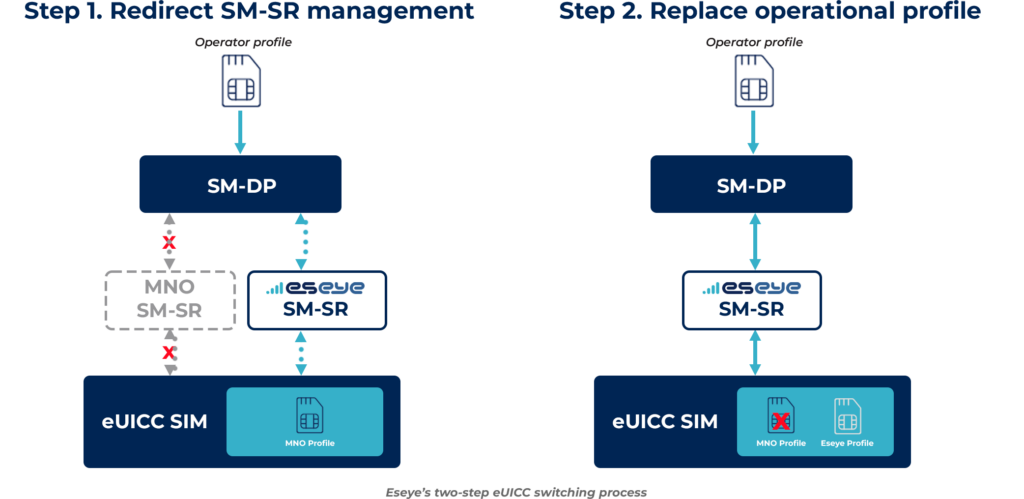IoT Explained
12 December 2023
Reading Time: 4 mins
IoT Explained
12 December 2023
Reading Time: 4 mins

Paul Marshall
Founder & CCO
LinkedIneUICC (Embedded Universal Integrated Circuit Card) technology allows IoT devices to switch between mobile network operators without changing the SIM card. This flexibility helps ensure consistent connectivity and reduces the need for physical SIM replacements, enhancing device management and operational efficiency.
You’ve invested considerable time, effort and resources into building your smart connected product. Why go and throw it all away by settling for inferior connectivity?
Changing to another network provider might be easier than you think… Discover how we can help you make the connectivity switch painless and easy in just two steps.
Eseye’s 2023 State of IoT Adoption survey found that only 1% of businesses are achieving highly resilient connectivity. Achieving above 98% should be the standard in today’s high tech environment. Imagine IoT health devices losing their connection and the impact that might have on life, or an EV charger failing because of defective connectivity and the millions of pounds in revenue lost as a result, not to mention stranded drivers or the impact on brand reputation.
Even more alarmingly, despite not achieving particularly high connectivity levels, 96% of companies said they were satisfied with the service delivered by their connectivity provider. Businesses are compromising their chances of success by settling for second-rate connectivity. Why might this be the case?
eUICC stands for embedded universal integrated circuit card (eUICC). It refers to the software component of eSIM that runs on a UICC and provides the capability to store multiple network profiles that can be provisioned and managed over-the-air (OTA). The term eUICC is often used to mean the whole physical card or chip.
eUICC switching from one MNO service to another involves signing a new contract, agreeing on new data plans and navigating a new management tool that does the switching. It can be extremely time consuming and manual but it doesn’t have to be. Here at Eseye, we cover all of that so that you don’t have to.
Firstly we transfer the control of the eUICC switch. We do this by leveraging Remote SIM Provisioning (RSP) and Subscription Manager Secure Routing (SM-SR).
RSP is the secure management of network profiles on eUICC-enabled devices using over-the-air commands. RSP uses secure communication channels to download, install, activate, and delete network profiles on devices. To ensure security and interoperability, all eUICCs and RSP systems must achieve GSMA certification to operate within the eSIM ecosystem.
The SM-SR securely delivers encrypted operator credentials to the SIM and remotely manages the SIM. Access to the SM-SR is critical to enable seamless network switching. Without it, localising or switching networks over-the-air (OTA) can cause complications and delays.

First we need to gain control of the SM-SR so that we can complete the network switch, so we send a software update over-the-air which instructs the SM-SR management to redirect over to us.
Once this initial step is complete, we move onto the network operator switch. Using the original network the device was connecting through, we download our new IMSI profile to the SIM so we are in control. Once that’s successfully in place, the customer can cancel the other network operator’s contract and remove that IMSI from the SIM.
The whole two-step process is extremely quick and we can transfer-in thousands of IoT devices per hour to our award-winning AnyNet cellular connectivity solution.
Currently, we are moving eUICC devices onto our Connectivity Management Platform for a leading retail brand. Once this is completed, we believe that we will have managed the largest transfer-in of eUICC devices in the world. As I write, it has been achieved without losing a single device, or requiring a single site visit to repair or replace a device. The good news? We can do it for you too.
If you’re unhappy with your current IoT network provider, our research has proven you are not alone. Customer loyalty and retention can be negatively impacted by poor connectivity, which can damage your brand’s reputation. It’s important to get it right.
Cost is certainly a factor impacting that is clouding decision-making. Nearly every respondent (95%) in our survey said that cost was an important aspect of their decision when choosing their connectivity provider. Yet 72% admitted that cheap IoT connectivity providers aren’t a good long-term investment which suggests they may have been impacted in the past.
Our advice? Think twice before settling for low cost connectivity rates that could kill your IoT business case. Don’t compromise for substandard connectivity. Look for connectivity partners who can offer you the connectivity coverage and uptime that your IoT initiative demands and deserves. Go for gold – that’s as close to 100% connectivity coverage and therefore uptime for your device.
Speak to an IoT specialist today about transitioning to a new connectivity provider using eUICC.
Book a meeting
Paul Marshall
Founder & CCO
LinkedInPaul is one of Eseye’s co-founders. With a background in senior design engineering, Paul’s focus is on ensuring his development, operations and support teams deliver solutions that work faultlessly in the field.
Paul was co-founder of CompXs, with Ian Marsden, and developed the world’s first IEEE 802.15.4 radio. Before CompXs, Paul was in senior radio design at Philips.
Let our experts test your device for free. Receive a free SIM kit and speed up your IoT deployment with expert insights and seamless connectivity.